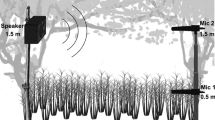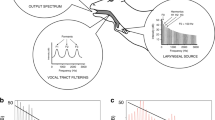Summary
It has long been asserted that habitat acoustics can determine the frequency band bestadapted for long-range communication, but the generality and validity of measurements claiming to demonstrate a “window” of best frequencies have recently been questioned. We report the discovery of a prominent sound window in Kenyan rain forest in a study that is free of methodological difficulties. Our results allow us to calculate the range advantage attained by an animal vocalizing within the sound window, and show that sound windows can be a potent factor for the evolution of primate communication.
Similar content being viewed by others
References
Aylor D (1971) Noise reduction by vegetation and ground. J Acoust Soc Am 51:197–205
Bowman RI (1979) Adaptive morphology of sound dialects in Darwin's finches. J Ornithol 120:353–389
Brenowitz EA (1982) The active space of red-winged blackbird song. J Comp Physiol 147:514–522
Brown CH, Schwagmeyer PL (in press) The vocal range of alarm calls in thirteen-lined ground squirrels. Z Tierpsychol
Brown CH, Waser PM (in press) Hearing and communication in blue monkeys. Anim Behav
Embleton TFW (1963) Sound propagation in homogeneous deciduous and evergreen woods. J Acoust Soc Am 35:1119–1125
Eyring C (1946) Jungle acoustics. J Acoust Soc Am 18:257–270
Gautier JP (1971) Emissions sonores d'espacement et de ralliement par deux cercopitheques arboricoles. Biol Gabonica 7:229–267
Gautier JP, Gautier A (1977) Communication in old world monkeys. In: Sebeok TA (ed) How animals communicate. Indiana University Press, Bloomington, pp 890–964
Marler P (1973) A comparison of vocalizations of red-tailed monkeys and blue monkeys, Cercopithecus ascanius and C. mitis in Uganda. Z Tierpsychol 33:223–247
Marten K, Marler P (1977) Sound transmission and its significance for animal communication: temperate habitats. Behav Ecol Sociobiol 2:271–290
Marten K, Quine D, Marler P (1977) Sound transmission and its significane for animal communication: tropical forest habitats. Behav Ecol Sociobiol 2:291–302
Michelsen A (1978) Sound reception in different environments. In: Ali BA (ed) Perspectives in sensory ecology. Plenum Press, New York, pp 345–373
Morton E (1975) Ecological sources of selection on avian sounds. Am Nat 109:17–34
Oates JF, Trocco T (1982) Phylogenetic relationships and taxonomy of black-and-white colobus monkeys: the implications of loud calls. Folia Primatol 40:83–113
Piercy JE, Embleton TFW, Sutherland LC (1977) Review of noise propagation in the atmosphere. J Acoust Soc Am 61:1403–1418
Roberts J, Kacelnik A, Hunter MJ (1979) A model of sound interference in relation to acoustic communication. Anim Behav 27:1271–1273
Skudrzyk E (1971) The foundations of acoustics. Springer, Berlin Heidelberg New York
Waser PM (1982) The evolution of male loud calls among mangabeys and baboons. In: Snowdon C, Brown C, Petersen M (eds) Primate communication. Cambridge University Press, Cambridge, pp 117–143
Waser PM, Waser MS (1977) Experiment studies of primate vocalization: Specializations for long distance propagation. Z Tierpsychol 43:239–263
Wiener FM, Keast PN (1959) Experimental study of propagation of sound over ground. J Acoust Soc Am 31:724–733
Wiley RH, Richards J (1978) Physical constraints on acoustic communication in the atmosphere: implications for the evolution of animal vocalizations. Behav Ecol Sociobiol 3:69–94
Wiley RH, Richards J (1982) Adaptations for acoustic communication in birds: sound transmission and signal detection. In: Kroodsma DH, Miller EH (eds) Ecology and evolution of acoustic communication in birds. Academic Press, New York, pp 131–181
Author information
Authors and Affiliations
Rights and permissions
About this article
Cite this article
Waser, P.M., Brown, C.H. Is there a “sound window” for primate communication?. Behav Ecol Sociobiol 15, 73–76 (1984). https://doi.org/10.1007/BF00310219
Received:
Accepted:
Issue Date:
DOI: https://doi.org/10.1007/BF00310219




